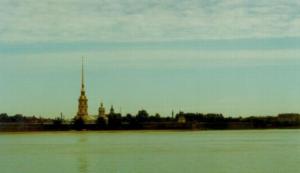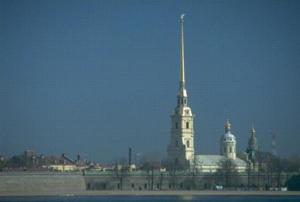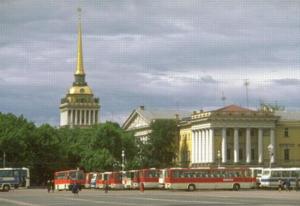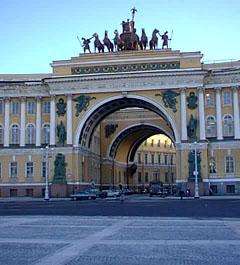
Russian city founded in 1703.
Russia's capital 1712 - 1918;
1914 - 1924: Petrograd,
1924 - 1991: Leningrad.
Saint Petersburg was founded by Tsar Peter the Great in 1703 on the marshy estuary of the Neva River, where the river meets the Gulf of Finland (Baltic Sea), as a window and showpiece to western Europe. The foundation stone for the Peter-and-Paul Fortress on Zayachy Island was laid on 16 May (27 May in the old Russian calendar). This was followed by the establishment of the fortress of Kronshlot (later Kronstadt) on Kolin Island in 1704.
From the beginning Saint Petersburg was planned as an imperial city with broad avenues, wide places and splendid buildings. The first small house, built as the initial abode for the tsar, is now a museum; but within only a few decades the city impressed visitors with its Russian baroque, characterized by simple lines but rich decoration, and the later classicism.
In 1712, nine years before Sweden formally acknowledged its loss of the area to Russia, the tsar decided to transfer the capital from Moscow to Saint Petersburg. He made it the cradle of Russian industrial development and the centre of intellecutal life. Well known names connected with the city include Lomonosov, Mendeleyev and Pavlov in science and Pushkin, Tolstoy, Dostoyevsky and others in literature. The first Russian railways were built from Saint Petersburg, and Peter the Great himself established the first Russian shipyard on the Neva River.
The city grew rapidly during the 19th century, from 539,000 inhabitants in 1864 to 1.5 million in 1900 and 2.5 million in 1917. When World War I broke out in 1914 the German connotation in its name was replaced by its Russian equivalent and the city renamed Petrograd. By that time the number of factory workers had exceeded 250,000, many of them working in large establishments; the Putilov armament factory (now the Kirow armament works) alone employed 13,000 people.
With this concentration of working class Saint Petersburg became the centre of the October Revolution, which began with a revolt of the Kronstadt sailors. The city suffered greatly during this period of civil war, and its population fell to 722,000 in 1920. The new Soviet government transferred the capital back to Moscow in 1918, and after Lenin's death in 1924 Petrograd was renamed Leningrad.
During World War II Hitler's army besieged the city for 872 days (from 8 September 1941 to 27 January 1944), causing the death of over 660,000 people. Bombardment and willful destruction by the retreating German army destroyed several of the original palaces. Leningrad received the title "Hero City", and the Order of Lenin was conferred on it. The city reached its prewar size of 3 million people in 1960 and passed 4 million in the 1980s.
Today Saint Petersburg, as it is again known since the end of the Soviet Union in 1991, is an international city and one of the gems of European civilization. Its galleries and museums contain masterpieces from several centuries and attract visitors from all over the world.

The Neva River, Saint Petersburg

The Peter and Paul fortress

The Heritage Gallery and the Admiralty Tower

The Grand Triumph Arch
Photos: check the copyright status.